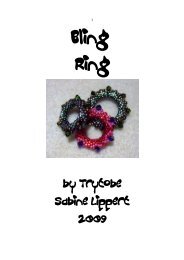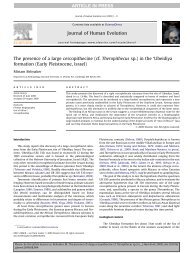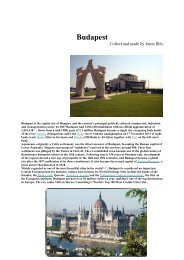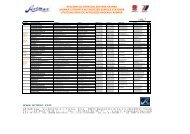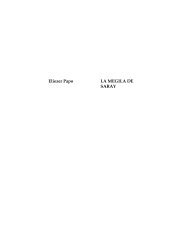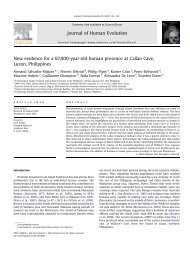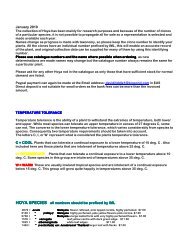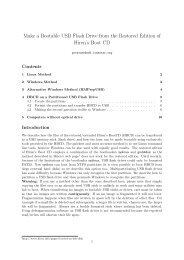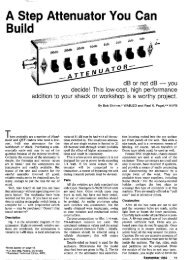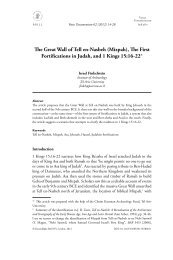Creativity, primordial cognition, and personality
Creativity, primordial cognition, and personality
Creativity, primordial cognition, and personality
Create successful ePaper yourself
Turn your PDF publications into a flip-book with our unique Google optimized e-Paper software.
1782 C. Martindale / Personality <strong>and</strong> Individual Differences 43 (2007) 1777–1785<br />
(SD = 86.13) words, with an average of 9.55% (SD = 2.88) falling into the <strong>primordial</strong> categories,<br />
9.255% (SD = 1.69) into the conceptual categories, <strong>and</strong> a resultant net <strong>primordial</strong> score of .44%<br />
(SD = 4.13). Factor analyses showed the <strong>primordial</strong> categories loading on one end of the first<br />
unrotated factor <strong>and</strong> the conceptual categories loading on the opposite end. A scree plot suggested<br />
that a second factor, with an eigen value of barely over 1.00 be ignored. Thus, the measure<br />
of <strong>primordial</strong> content was behaving as it always has.<br />
The average Alternate Uses Test score was 29.28 (SD = 8.84). For men, the average number of<br />
uses given for a brick correlated .46 with the number of uses for a shoe <strong>and</strong> .55 with the number of<br />
uses given for a newspaper, whereas the number of uses given for a shoe correlated .53 with the<br />
number given for a newspaper. For women, the correlations were .79, .59 <strong>and</strong> .69, respectively. In<br />
all cases, p < .001. Though higher for women, the AUT was judged to have adequate internal<br />
consistency.<br />
The average Remoteness of Associations score was 1928.4 (SD = 679.2) for men <strong>and</strong> 1719.1<br />
(SD = 552.1) for women. To assess internal consistency, I correlated remoteness of association<br />
on the first 50 items <strong>and</strong> the last 50 items. For men, the correlation was .78, p < .001, whereas<br />
for women it was .31, p < .05.<br />
The average rated story creativity score was 5.18 (SD = 2.14) for men <strong>and</strong> 6.26 (SD = 1.83) for<br />
women. For stories rated by more than one rater, the correlation between the two raters was<br />
r(18) = .71, p < .001 for men <strong>and</strong> r(18) = .75, p < .001 for women. The three measures of potential<br />
creativity were in no case significantly related with one another. The highest correlation was .14<br />
between remoteness of associations <strong>and</strong> story creativity in men. Under the assumption that they<br />
were measuring independent aspects of potential creativity, they were st<strong>and</strong>ardized <strong>and</strong> added<br />
together to form a composite creativity index. For purposes of brevity, this is simply referred<br />
to as creativity below.<br />
Scores for the EPQ-R for men, women, <strong>and</strong> the total sample are shown, along with their correlations<br />
with creativity <strong>and</strong> <strong>primordial</strong> content, in Table 1. As is usually the case, women had<br />
lower psychoticiism scores than did men, t(98) = 3.22, p < .01. They also had considerably<br />
higher extraversion scores, t(98) = 4.27, p < .001. Men had higher neuroticism scores, t(98) =<br />
2.32, p < .05.<br />
The scores for extraversion <strong>and</strong> neuroticism were correlated for men: r(48) = .30, p < .05. For<br />
women, the lie scale was negatively correlated with neuroticism, r(48) = .33, p < .05. For the<br />
total group, the lie scale correlated negatively with extraversion, r(98) = .26, p < .01. Primordial<br />
content <strong>and</strong> creativity were correlated .37, p < .01 for men <strong>and</strong> .28, p < .05.<br />
For the male sample, results are essentially in conformity with expectations. As may be seen in<br />
Table 1, creativity was positively correlated with extraversion <strong>and</strong> psychoticism to about the same<br />
degree. However, <strong>primordial</strong> content was much more strongly related to extraversion than to<br />
psychoticism. As noted above, creativity <strong>and</strong> <strong>primordial</strong> <strong>cognition</strong> were positively related. The<br />
results closely replicate those of Martindale <strong>and</strong> Dailey (1996). If we take extraversion <strong>and</strong><br />
psychoticicism as proxy measures of disinhibition, the results are what we would expect from<br />
the theory presented in Section 1.<br />
For women, we do find a relationship between creativity <strong>and</strong> extraversion, but <strong>primordial</strong> content<br />
does not enter the picture. Though not predicted, the negative correlation between creativity<br />
<strong>and</strong> the Lie scale makes sense. I know of no study in which the Lie scale has shown a significant<br />
positive relationship with creativity. At first glance, it would seem that the theory presented in



